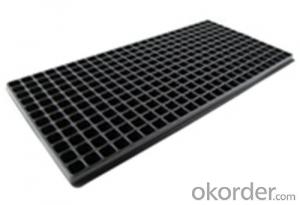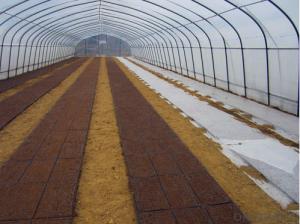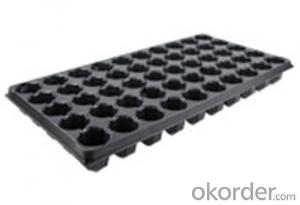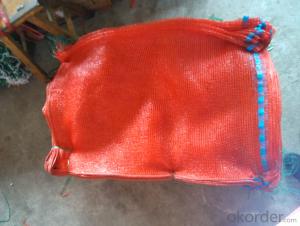Plastic Seed Tray Plug Tray for Green House Tray Square Plug Tray
- Loading Port:
- China main port
- Payment Terms:
- TT OR LC
- Min Order Qty:
- 1000 pc
- Supply Capability:
- 100000 pc/month
OKorder Service Pledge
OKorder Financial Service
You Might Also Like
Structure of the seed tray:
Top quality and competitive price.
Variety design and good appearance.
Easy to use, and remove.
Durable and reusable.
Eco-Friendly.
Description Main Features of the seed tray:
Ideal for Starting seeds and Transplanting Seedling.
Suitable for both manual and automatic planting.
Suitable for Propagating Vegetables, Flowers and other plant from seed in green-house or indoors.
Seed Tray Images:


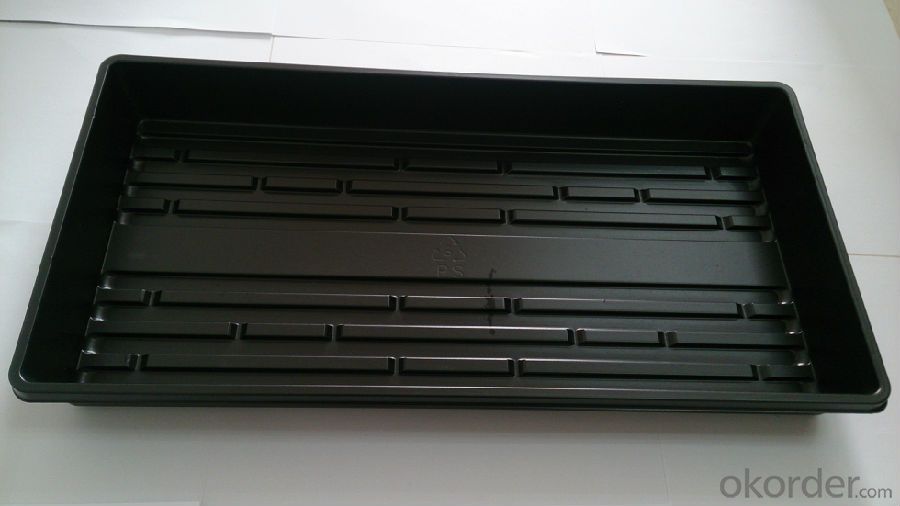
Seed Tray Specification:
Material: HIPS/PVC
Thickness: 0.5mm-1.5mm, Standard:1mm
Weight: 80g(±5)g-230g(±5)g, Standard weight:155g(±5)g
Size: length:490mm-540mm, width:190mm-345mm,depth:25mm-150mm
Standard:54mmX28mm
Cell count: 18-512
Package: carton
Using time: 8-10 times
FAQ:
Q:How Can I Get A Sample?
A:You can get samples by communicate with our export sales.
Q:How Long Is Delivery?
A:Delivery time will be 7-25 days according to order quantity.
Q:What Is The MOQ?
A:Our MOQ is 1*20FT container quantity, allow to mix several items.
Q:What Is Our Normal Payments Terms?
A:Our normal payment terms now is T/T, L/C or Western Union,Papal.
Q:How Do I Order Your Products?
A:You can check our website for any items you interest and you can also get communication with our export sales and order for it accordingly.
Q:What Kinds Of Material We Use In Our Product?
A:Our plastic flower pots use material such as PP polymer or PE polymer.
Thickness vs. Weight
Thickness of trays are from 0.5mm to 1.0mm.
1.0mm: 155g±5g; 100pcs/ctn.
0.9mm: 140g±5g; 120pcs/ctn.
0.7mm: 110g±5g; 150pcs/ctn.
0.6mm: 95g±5g; 180pcs/ctn.
0.5mm: 80g±5g; 200pcs/ctn.
Using time:
thickness of 0.5mm can be used 1 to 2 times.
thickness of 0.6mm can be used 3 to 4 times.
thickness of 0.7mm can be used 5 to 6 times.
thickness of 0.8mm can be used 7 to 8 times.
thickness of 0.9mm can be used 8 to 9 times.
thickness of 1.0mm can be used 8 to 10 times.
- Q: What types of plastic materials are used in making shade structures?
- Some common types of plastic materials used in making shade structures include high-density polyethylene (HDPE), polyvinyl chloride (PVC), and polycarbonate.
- Q: Can ground cover plants attract pollinators?
- Yes, ground cover plants can attract pollinators. They provide a source of nectar and pollen, attracting bees, butterflies, and other pollinating insects. Additionally, ground cover plants often offer shelter and protection for these pollinators, making them an important component of a pollinator-friendly garden or landscape.
- Q: Can someone tell 3 different forms to recycle or reused the plastic,but I need them short
- The common process that is used in recycling plastic is the inverse polymerization process where the polymers in the plastic are converted into initial monomers that were used in the manufacture. These chemicals are then purified and synthesized to form new plastic materials. Assorted polymers are converted into petroleum in another recycling process. The advantage of this process is that any mix of polymers can be used. A new recycling process generates heat from the friction of plastic materials which melts the plastics. This is then pumped into casting moulds. The great advantage of this technique is that all types of plastics can be recycled.
- Q: Can ground cover be grown in containers?
- Yes, ground cover can be grown in containers. In fact, many varieties of ground cover are well-suited for container gardening.
- Q: I recently bought a 2.5 gallon plastic tank. I wanted to add an electric heater, but the lady at the store said it might melt the plastic... I don't understand how it could get so hot that it would melt the plastic.. I only wanted the heater to stabilize the temperature so it doesn't get too cold for my betta at night. Please help! Thanks,CJ
- Hi okorder /
- Q: What are some ground cover options for tropical gardens?
- Some ground cover options for tropical gardens include moss, ferns, ivy, creeping fig, mondo grass, and liriope.
- Q: What is the best ground cover for a native plant garden?
- The best ground cover for a native plant garden depends on various factors such as the specific location, climate, soil type, and the desired aesthetics. However, native grasses and wildflowers often make excellent ground covers for native plant gardens as they provide natural beauty, support local ecosystems, require minimal maintenance, and contribute to the overall health and biodiversity of the garden.
- Q: what is in common with crude oil separation and the production of plastics.
- Carbon. Carbon is in common with crude oil and plastics. Crude oil is the feedstock for the plastics industry, as well as the pharmaceutical industry, not to mention the fuels industry. Carbon is found in crude oil and carbon is literally the backbone of plastics. Plastics exist because carbon atoms can bond with themselves to make long chains of carbon atoms which are necessary for the production of plastic.
- Q: i have a plastic knife, but its getting dull, ive searched on google but no result, could anyone help me?
- Sharp Plastic Knife
- Q: Are there any alternatives to using agricultural plastic products?
- Yes, there are several alternatives to using agricultural plastic products. Some of these alternatives include using biodegradable materials such as bio-based mulches, compostable plant pots, and natural fiber-based packaging. Additionally, farmers can explore sustainable practices such as organic farming methods, crop rotation, and integrated pest management to reduce the need for plastic products in agriculture.
Send your message to us
Plastic Seed Tray Plug Tray for Green House Tray Square Plug Tray
- Loading Port:
- China main port
- Payment Terms:
- TT OR LC
- Min Order Qty:
- 1000 pc
- Supply Capability:
- 100000 pc/month
OKorder Service Pledge
OKorder Financial Service
Similar products
Hot products
Hot Searches
Related keywords



